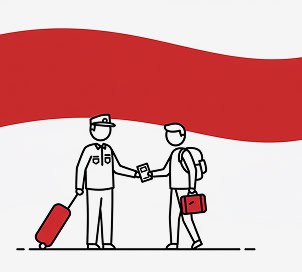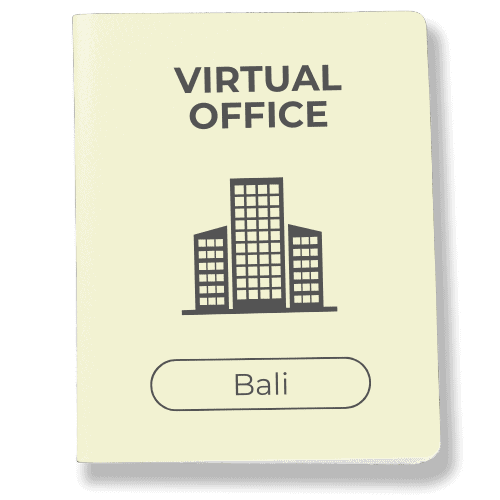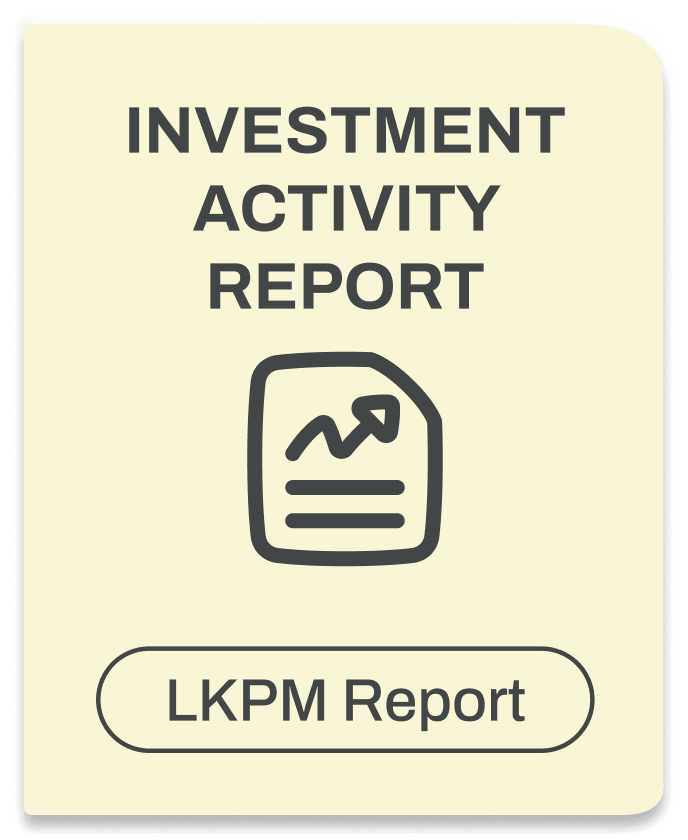Avoid the Traps on Your First Family Trip to Bali

Bali is absolutely magical for families, picture your kids running on warm sand, watching traditional dances, and making friends with gentle sea turtles. But here’s the thing: the island’s distances, tropical heat, and tourist crowds can completely burn you out if you plan this trip the same way you’d plan a romantic getaway. When our family arrived in Bali, we instantly felt the excitement of leaving the long journey behind and stepping into a new adventure together. This guide gives you clear, age-specific itineraries, real safety advice, and the visa steps you actually need so your kids (and let’s be honest, you too) actually have fun instead of melting down.
Quick credibility note: This comes from a Bali-based team that works with family travelers every single day on visas, extensions, and long-stay planning, with fresh updates each season.
Before You Book: Visas & Entry (Fast, Simple, Family-Proof)
Let’s start with the paperwork because nothing ruins a vacation faster than visa confusion at the airport.
Most families visiting Bali need either an e-VOA (electronic Visa on Arrival) or get a VOA when they land. The e-VOA is basically a tourist visa that gives you 30 days in Indonesia, and you can extend it once for another 30 days. You apply online before you fly, which means you skip the long VOA counter at the airport, a huge win when you’ve got tired kids. Citizens from over 90 countries can use this system, including Americans, Canadians, Europeans, and Australians. While family holidays in Australia often mean familiar destinations like the Gold Coast or Queensland, a family trip to Bali offers a unique and exciting experience that stands out from the usual Australian getaways.
Here’s the smart move: if you’re staying longer than 30 days, apply for the e-VOA and set up your extension before you even pack your bags. Extensions aren’t hard, but they take time and a visit to an immigration office. Nobody wants to spend their 28th day in Bali hunting for paperwork with cranky kids in tow.
Family situations get tricky sometimes. If you’re a single parent traveling with your kids, bring a notarized consent letter from the other parent. If your kids have different last names than you (maybe from a previous marriage or hyphenated names), bring their birth certificates. Indonesian immigration officers might ask questions, and having the documents ready makes everything smooth.
One more thing before you land: fill out the Indonesia All Indonesia arrival card. You can do this online starting three days before arrival. It’s quick, takes about five minutes, but doing it ahead means one less thing to juggle while managing luggage and jet-lagged children at Denpasar Airport.
Need help with your family’s visa? Check your visa path in two minutes at Visa-Indonesia.com. They process e-VOA applications and tourist visa extensions so you don’t have to stress about it.
When to Go (Weather, Crowds, School Holidays)

Bali has two main seasons: dry (April through October) and rainy (November through March). The dry season sounds perfect, right? Well, it’s also when everyone else wants to visit. July and August get absolutely packed with Australian families on winter break, Europeans on summer holiday, and Americans escaping to sunshine.
Many families have spent their holidays in Bali during both the busy dry season and the quieter rainy months, enjoying a range of family-friendly activities no matter when they visit.
The rainy season isn’t as scary as it sounds for families. You usually get afternoon showers that last an hour or two, not all-day downpours. Morning activities work great, then you head inside for lunch and a nap while it rains, and evenings often clear up beautifully. Plus, hotels cost less and attractions have shorter lines.
Here’s a reality check about the heat: Bali sits close to the equator, so it’s hot year-round. Between 10:30 AM and 3:30 PM, the sun is seriously intense. Little kids overheat fast, and nobody has fun when someone’s getting sunburned or heat-exhausted. Plan your big outdoor activities for early morning (before 10 AM) or late afternoon (after 4 PM). Use that midday window for swimming, naps, or air-conditioned museums.
When rain messes up your plans, Bali has fantastic backup options. Book a Balinese cooking class where kids can make satay or spring rolls. Try a batik workshop where everyone designs their own fabric. Check out the kids’ spa treatments (yes, really, gentle massages and flower baths). Hit up the indoor playgrounds in the big malls around Seminyak and Denpasar.
Where to Base with Kids (Area by Area, Age-Rated)
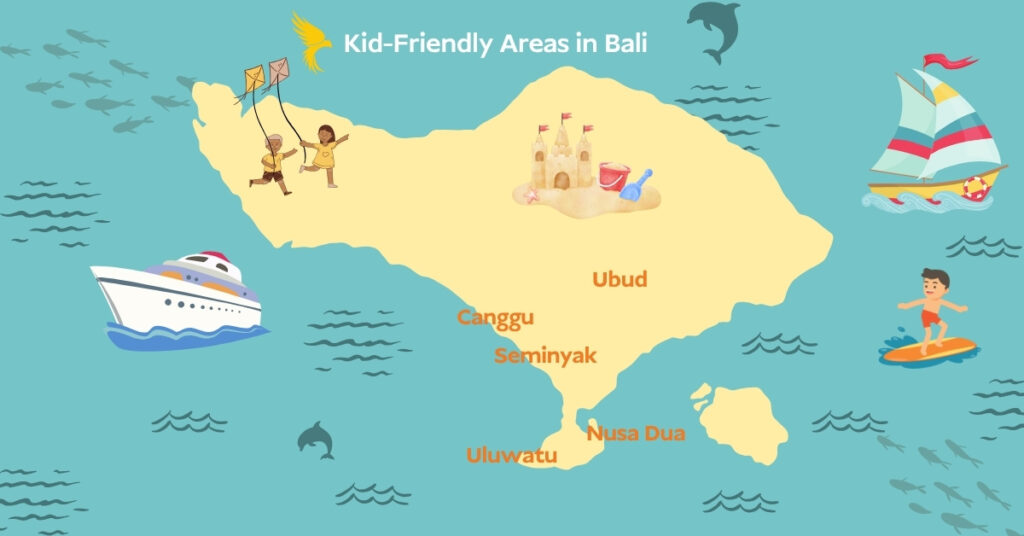
Picking the right home base makes or breaks a family trip. Here’s what you need to know about each area. Some families choose to stay at three different hotels in Bali, each in a different region, to experience the diversity of the island and cater to everyone’s preferences.
Sanur is the champion for families with babies and toddlers (ages 0-6). There’s a paved beachfront path perfect for strollers and bikes, the beach has calm water for splashing, and the whole vibe is mellow. Restaurants have high chairs, staff are patient with kids, and you can walk to most things. It’s not fancy, but it’s functional and stress-free.
Nusa Dua wins for resort lovers with kids up to age 10. The big hotels here have kids’ clubs, multiple pools, gentle beaches protected by a reef, and organized activities. You’re basically in a family-friendly bubble. The downside? You’re far from “real” Bali culture, and taxis to anywhere interesting take 45 minutes or more. But if you want to relax and let the resort entertain your kids, this is your spot.
Seminyak and Legian work better for families with older kids and teens. You get fantastic restaurants, shopping, surf lessons, and a lively beach scene. But sidewalks are sketchy, traffic is intense, and you’ll need rides everywhere. Not ideal for strollers or little kids who dart into streets.
Canggu has become super popular with the café and surf crowd. Teens love it, but the traffic is genuinely terrible, scooters everywhere, narrow roads, and very few sidewalks. If your kids are old enough to handle chaos and you’re spending most time at your villa or the beach, it can work. Otherwise, skip it.
Ubud offers the most culture, rice terraces, temples, traditional dance, craft villages. It’s stunning and educational. But it’s also hot, humid, hilly, and definitely not stroller-friendly. The Monkey Forest has actual wild monkeys (more on safety later). Plan this as part of a longer trip when kids are rested, and build in lots of shade breaks and naps.
Uluwatu sits on dramatic cliffs in the south. The beaches are gorgeous but require walking down steep stairs, not happening with a stroller or baby carrier. The surf is strong, which is great for confident teen swimmers but scary for little kids. Base here if your family is active and adventurous, not if you’ve got toddlers.
Getting There: Realistic Transfer Times
Here’s what you need to know about getting from the airport to your base:
- Sanur: 30-40 minutes with no traffic, up to 90 minutes during rush hour
- Nusa Dua: 25-35 minutes, pretty consistent
- Seminyak: 45-60 minutes, longer during peak traffic
- Canggu: 60-90 minutes, traffic-dependent
- Ubud: 90 minutes minimum, often 2+ hours with stops
Add potty breaks and snack stops to whatever time you think it’ll take. And yes, roadside bathrooms vary wildly in quality, pack wet wipes and hand sanitizer.
Getting Around Safely (Car Seats, Scooters, Drivers)
Transportation in Bali is nothing like back home. You need to plan this carefully.
Car seats and boosters are rare. Most taxis and drivers don’t have them. You can bring your own (some airlines let you check car seats free), or rent them from baby gear companies in Bali. Honestly, many families hire a private driver for the day and bring a portable booster seat or travel harness. It’s not perfect, but it’s way safer than nothing.
A full-day private driver costs about 600,000 to 750,000 Indonesian Rupiah (roughly $40-50 USD). That includes the vehicle, gas, and the driver who knows the roads and parking situations. Make sure they speak enough English to understand where you’re going and can handle kid-friendly stops. Good drivers know where the clean bathrooms are and will suggest snack breaks.
About scooters: You’re going to see families riding scooters, even with babies. Please don’t. Bali’s traffic is unpredictable, drivers are aggressive, and the roads have potholes and random obstacles. If you absolutely must ride a scooter, make sure every single person has a proper helmet that actually fits. But really, with kids, just don’t.
Plan your daily routes with a maximum of two main stops plus a play break. Kids can’t handle five temples and a waterfall in one day, no matter what your itinerary says. Two good experiences beat six rushed, cranky ones every time.
Many families have also walked to nearby attractions or along the beach as a safe and enjoyable way to explore.
Health & Safety (Bali Belly, Heat, Mosquitoes, Pools)
Let’s talk about the thing every parent worries about: Bali belly. It’s basically traveler’s diarrhea, and it’s super common. Here’s how to avoid it:
- Only drink bottled or filtered water, never from the tap
- Be careful with ice, fancy hotels and restaurants use filtered water, but small warungs might not
- Wash hands constantly, especially before eating
- Peel your own fruit instead of buying pre-cut
- Be cautious at buffets where food sits out in the heat
- Avoid street food unless it’s cooked fresh in front of you
Age-by-Age Playbook (What Actually Works)
Different ages need completely different vacations. Here’s what to plan for each group.
For example, during our last trip, our daughter especially enjoyed the animal encounter at the local wildlife park, making it a memorable family experience.
Babies (0-2 Years)
Your trip revolves around naps, shade, and routine. Base in Sanur or Nusa Dua where you can stroller around easily. Rent baby gear (cribs, high chairs, bottle sterilizers) instead of flying with it all. Beach mornings work great, before 10 AM, let them splash in shallow water and play in sand. Skip the temples and long car rides. Find a villa with a kitchen so you can prepare familiar foods.
Toddlers (3-5 Years)
Waterbom Bali’s shallow areas are perfect, arrive right when it opens at 9 AM before crowds. Keep temple visits under 30 minutes, and yes, ice cream bribes are completely acceptable. Bali Safari and Bali Bird Park work well because kids can see animals without hiking miles. Bali Bird Park is especially great for toddlers, offering an educational experience focused on conservation and recreated natural habitats. Always have a quiet retreat option when they get overstimulated.
Kids (6-9 Years)
This age can handle more adventure. Walk the Tegallalang rice terraces (early morning only), try simple snorkeling at calm beaches like Amed, take a village craft class where they make offerings or try woodcarving. When we visited the Tegallalang rice terraces, the lush green views and intricate irrigation channels really fascinated the kids. They’re old enough to learn about culture but young enough to need frequent breaks and snacks.
Tweens and Teens (10-16 Years)
Now you can do the cool stuff. Book surf lessons through a proper school with certified instructors. Try white-water rafting or canyoning, but check operator safety records and equipment first. Hike up to Campuhan Ridge Walk in Ubud for sunrise. Visit the Uluwatu Temple for sunset and the Kecak fire dance. For an unforgettable adventure, consider a day trip to Nusa Penida to snorkel at Crystal Bay or explore the island’s incredible marine biodiversity. They’ll actually remember this trip and think you’re cool for once.
Crowd-Smart, Kid-Happy Itineraries (Templates You Can Tweak)
Every itinerary should follow the same rhythm: active morning (when it’s cool), siesta midday (when it’s hot), gentle evening (when it’s beautiful). Be sure to schedule relaxing afternoons or evenings to help families recharge and fully enjoy their time together. Here are templates you can adjust.
3-Day Quick Trip
Day 1: Arrive, settle in Sanur or Nusa Dua, gentle beach time, early dinner, early bed.
Day 2 (Water Day): Start your day with a delicious breakfast at your hotel before heading out for a morning at Waterbom Bali or beach swimming. Afternoon pool and nap at your hotel. Evening walk on Sanur beach path for sunset.
Day 3 (Culture Day): Early morning visit to a nearby temple (Tanah Lot or Uluwatu). Lunch at a family restaurant. Afternoon craft workshop or cooking class. Evening Kecak dance if kids are up for it.
7-Day Classic Trip
Split your time: four nights at the beach, three nights in Ubud.
Many hotel guests enjoy family-friendly amenities and consistently report positive experiences during their stays.
Days 1-2: Beach base, recover from travel, swim, relax.
Day 3: Waterbom or water sports (banana boat, easy snorkeling).
Day 4: Temple morning (Tanah Lot), beach afternoon, sunset dinner.
Day 5: Transfer to Ubud (stop at rice terraces on the way). Settle in, easy walk, find your favorite warung.
Day 6: Morning at Monkey Forest (safety rules below). Afternoon art market shopping. Evening traditional dance performance at Ubud Palace.
Day 7: Early rice terrace walk or swing (if kids want). Afternoon craft class. Transfer back to beach area or head to airport.
10-14 Day Stress-Free Trip
This is the sweet spot, enough time to really relax.
Days 1-5: Beach base (Sanur or Nusa Dua). Mix beach days with one water park day, one temple day, one just-chill-at-the-pool day.
Days 6-9: Ubud base. Rice terraces, Monkey Forest, temples, art villages, cooking class, traditional performances. Build in downtime, not every day needs three activities.
Days 10-12: Move to Uluwatu or Seminyak. Teen surf lessons, cliff-top temple sunset, beach clubs (some have great kids’ areas), nicer restaurants.
Days 13-14: Buffer days for weather, for someone getting sick, or for that one activity everyone loved and wants to repeat.
Every day should have maximum two main stops, one snack stop, and bathroom certainty. Transfer time counts as “doing something” in a kid’s mind, so a 90-minute drive to a temple is already half their patience gone.
Top Family Experiences (with Reality Checks)
Here are the places every family considers, with the truth about what to expect. Visitors should be mindful of peak times and practice respectful behavior when enjoying Bali’s popular attractions.
Waterbom Bali
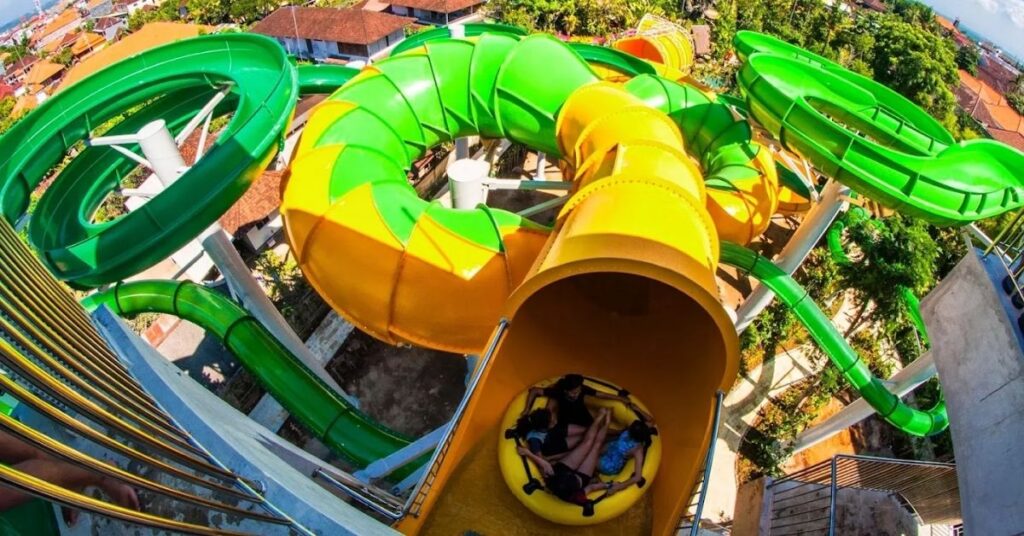
This water park is genuinely world-class. The lazy river is perfect for little kids, the big slides thrill teens, and the landscaping provides actual shade. Arrive right at opening (9 AM) to beat the crowds. Rent a cabana if you can, it gives you a home base and shade all day. Bring reef-safe sunscreen and reapply constantly. Plan to spend 4-5 hours, then leave before kids get too fried.
Ubud Monkey Forest
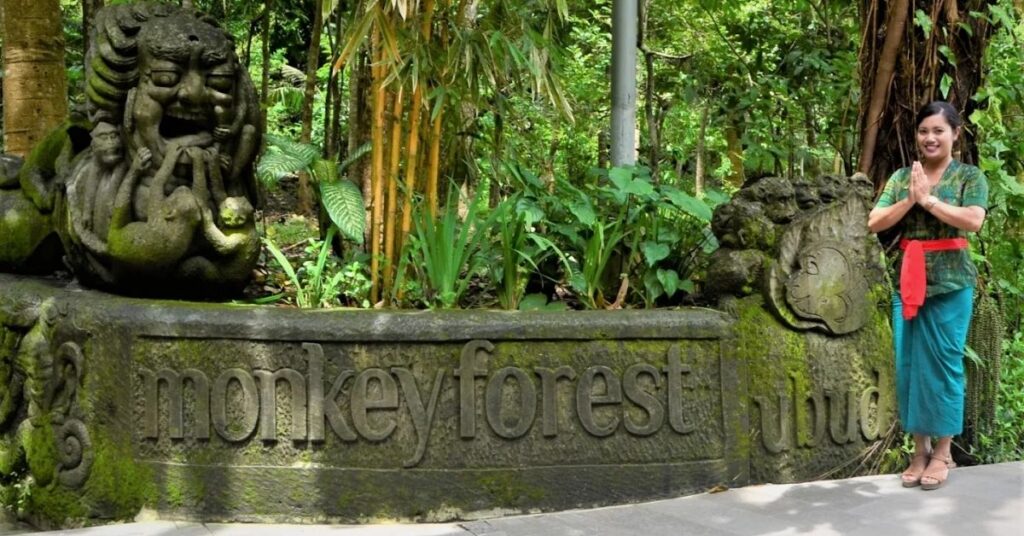
The monkeys here are wild animals, not pets. They’re cute but they can bite, scratch, and steal. Rules for safety: No food visible anywhere, not in bags, pockets, or hands. No touching monkeys or trying to pet them. No direct eye contact (they see it as a challenge). Zip up all bags and pockets, monkeys know how to open things. Keep glasses on your face, not your head. If a monkey approaches, stay calm and don’t run. Staff are everywhere to help, but prevention is better than panic.
During our visit, one monkey was especially mischievous, playfully tugging at a visitor’s bag and trying to snatch a water bottle. Encounters like this show why it’s important to stay vigilant at all times.
The forest is beautiful and cultural, there are temples throughout, but keep visits short with young kids.
Bali Safari & Marine Park
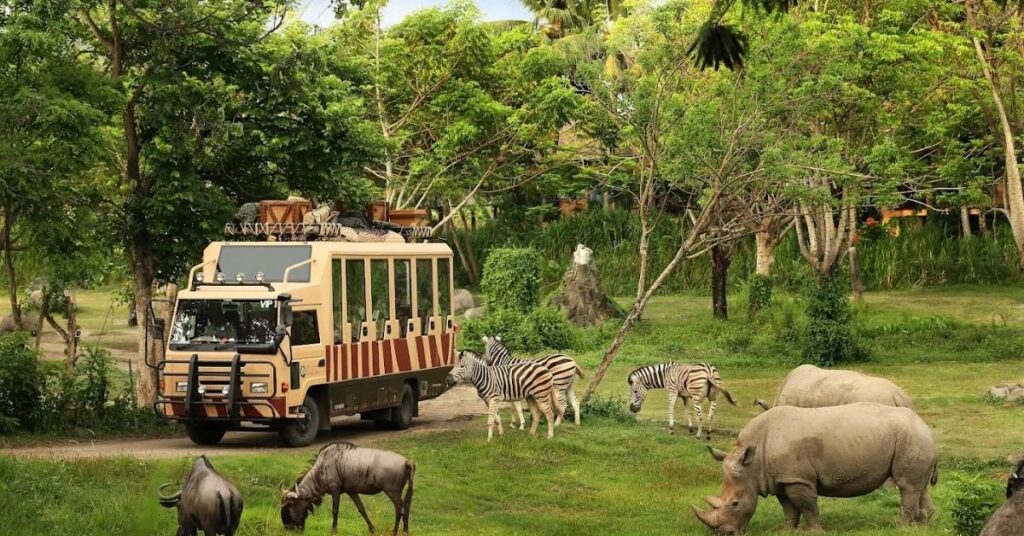
This is a half-day activity, max. The safari bus tour takes about 45 minutes and shows animals in large habitats. The animal shows are decent but happen at specific times, so check the schedule. There’s a water park section for kids. It’s hot and involves a lot of walking, so go early, see the main stuff, and leave before exhaustion sets in.
Beaches for Different Ages
Little kids need: Sanur Beach (calm, shallow, at sea level which contributes to its gentle waters), Nusa Dua Beach (protected by reef), Jimbaran Beach (gentle waves, clean).
Older kids and teens like: Seminyak Beach (surf lessons, beach clubs), Balangan Beach (beautiful, better swimmers), Amed (snorkeling).
Avoid with young kids: Uluwatu beaches (strong currents, steep access), Echo Beach in Canggu (powerful surf).
Temple Visits
Temples are gorgeous and important culturally. You’ll need a sarong (they usually rent or lend them at the entrance). Dress modestly, shoulders and knees covered. Be respectful with photos, no climbing on statues or turning your back to shrines. Some temples don’t allow menstruating women inside (it’s a spiritual purity thing, not meant as an insult).
Keep temple visits short with kids. Fifteen to twenty minutes is plenty for young ones. Explain ahead of time that it’s a holy place where people pray, so we use quiet voices and walking feet.
Visiting a Coffee Plantation: Beans, Views & Kid-Friendly Tastings

A visit to a Balinese coffee plantation (“Plantation Facility”) constitutes a surprisingly beneficial and informative undertaking for family units in their entirety. Establishments such as Kumulilir Coffee Plantation (“Service Provider”) facilitate the accommodation of minor participants through structured operational procedures. Such activities serve as an effective mechanism for the introduction of family units to Balinese cultural frameworks, as participants are provided with information regarding traditional agricultural methodologies and the significance of coffee production within local community structures.
Balinese Dance Performances: Culture Kids Will Remember

Balinese dance is a principal cultural offering for family visitors to the island. The Ramayana epic at Uluwatu Temple lets visitors watch performers in traditional dress at sunset over the Indian Ocean, as the temple’s cliff glows in evening light. Kids often get absorbed in the Kecak fire dance, where multiple performers move and chant in sync to tell historic stories.
Rice Terraces and Countryside: Easy Walks & Photo Ops

The “Jatiluwih Rice Terraces”, a UNESCO World Heritage Site, offer visitors a vivid glimpse of Bali’s agricultural beauty. Perfect for family walks along scenic walking paths, these emerald fields showcase traditional farming life. Children can spot birds among the paddies and watch local farmers at work, making it both an educational and picturesque experience.
Eating with Kids (Hygiene, Allergies, Picky Eaters)
Indonesian food is delicious but can be challenging with picky eaters. Here’s how to navigate it.
Warungs are small, family-run restaurants. They’re authentic and cheap, but hygiene standards vary. Look for busy ones (high turnover means fresh food) where locals eat. Avoid warungs if food is sitting uncovered or flies are everywhere.
Proper restaurants in tourist areas have reliable hygiene and often serve Western food alongside Indonesian dishes. They’re more expensive but worth it for peace of mind with kids.
For allergies, bring printed cards in Bahasa Indonesia explaining the allergy. Google Translate can help, but having it written out is clearer. Common allergies like nuts (kacang), shellfish (makanan laut), or dairy (susu) are easier to communicate. Be extra cautious, cross-contamination is common in kitchens.
Spice levels can be adjusted. Say “tidak pedas” (not spicy) when ordering. Most places know tourists can’t handle the heat and will tone it down.
Picky eaters can survive on nasi goreng (fried rice), mie goreng (fried noodles), plain satay (grilled meat on sticks), and french fries. Most restaurants will make plain rice or noodles even if it’s not on the menu. Pack backup snacks, granola bars, crackers, fruit pouches, for emergencies.
Always have water bottles with you. Kids get dehydrated fast in the heat, and bottled water isn’t always immediately available.
Budgeting for a Family (No Surprises)
Let’s break down what a family of four actually spends in a day.
Transportation: Private driver for the day: $40-50. Individual taxi rides: $5-15 each. Budget about $50-70 per day if you’re moving around, less if you stay at one beach.
Attraction tickets: Waterbom: $35 per person, kids under 2 free. Temples: $3-5 per person. Bali Safari: $45 per person. Budget $50-150 depending on what you’re doing.
Meals: Warung meal: $3-5 per person. Mid-range restaurant: $8-15 per person. Nice dinner: $20-40 per person. Budget $80-120 per day for three meals plus snacks.
Treats: Ice cream, coconut water, souvenir shopping: $20-40 per day.
Total daily spending: $200-380 for a family of four, depending on activities and meal choices.
Villa vs. resort math: A three-bedroom villa costs $80-200 per night. You get a kitchen (save money on some meals), more space, often a pool, but you handle everything yourself. A resort costs $150-400+ per night. You get kids’ clubs, organized activities, multiple restaurants, but less privacy and everything costs more once you’re there.
When to prebook: Buy attraction tickets online to skip queues and sometimes save money. Book your villa or hotel in advance. Everything else, meals, driver, small temples, you can do on the day.
Bali has ATMs everywhere in tourist areas. Carry small cash (20,000 and 50,000 rupiah notes) for small vendors, street food, and tips. Most restaurants and attractions take cards.
Tipping: Not required but appreciated. Round up taxi fares. Give 10,000-20,000 rupiah to helpful hotel staff. Leave 10% at nice restaurants if service charge isn’t included.
Multi-Gen & Group Trips: Avoid the Blow-Ups
Traveling with grandparents, aunts, uncles, and cousins sounds amazing until everyone has different ideas about money, schedules, and activities. Here’s how to keep the peace.
Pick one base, two maximum. Moving a big group between multiple hotels is a nightmare. Choose one place everyone stays together, or split into two nearby locations (like Seminyak and Canggu, which are close). Don’t try to do beach base, then Ubud, then Uluwatu with ten people.
Lock in big decisions early. Where you’re staying, travel dates, budget range, who’s sharing rooms, decide this months ahead via video call or group chat. Don’t try to figure it out the first night in Bali when everyone’s jet-lagged and cranky.
Create a shared WhatsApp or group chat with the daily plan, meeting times, and addresses. Assign roles: one person handles money collection, one person books drivers, one person manages restaurant reservations. Don’t make one person do everything or nobody do anything. If you’re traveling with your husband or spouse, coordinating plans together can help manage family activities and reduce stress.
Agree on meal budgets ahead of time. Maybe every third dinner is a splurge everyone chips in for, and other nights people grab cheaper meals on their own or in smaller groups. Money fights ruin vacations faster than anything.
If you’re traveling over Christmas or birthdays, decide on gifts before you go. Luggage space is limited, and shipping to/from Bali is expensive and slow. Maybe do photo gifts or experience vouchers instead of physical presents.
For multi-generational groups staying 30+ days, you’ll need visa extensions for everyone. Start this process early so you’re not burning vacation days at the immigration office. Visa-Indonesia.com can handle the timing and paperwork for your whole group.
Responsible & Respectful Travel with Kids
Teaching kids to be respectful travelers is part of the adventure.
At temples and sacred spaces: Explain before you go that these are like churches or synagogues, places where people pray and worship. We dress modestly (shoulders and knees covered), use quiet voices, and don’t run around. Let your kids ask questions about what they see, but brief them on respect first.
Wildlife ethics matter. Don’t let kids feed monkeys, it makes them aggressive and dependent on humans. Choose animal attractions carefully. Bali Safari is accredited and treats animals well. Elephant rides in Bali are often linked to animal abuse, skip them. If you’re doing any animal interaction, research the operator first.
Waste and water issues: Bali has a serious plastic problem. Use refill stations (many hotels and restaurants have them) instead of buying bottled water constantly. Bring reusable water bottles. Use reef-safe sunscreen, regular sunscreen damages coral reefs. Some beaches organize clean-ups, join one with your kids if you have time. It’s hands-on learning about environmental responsibility.
For a peaceful, educational, and scenic family outing, consider visiting Bali’s botanical gardens. These lush gardens offer a wonderful opportunity for kids to learn about local plants and enjoy nature in a tranquil setting.
Pack Like a Pro (Printable Checklists)
Here’s what actually needs to go in your suitcase.
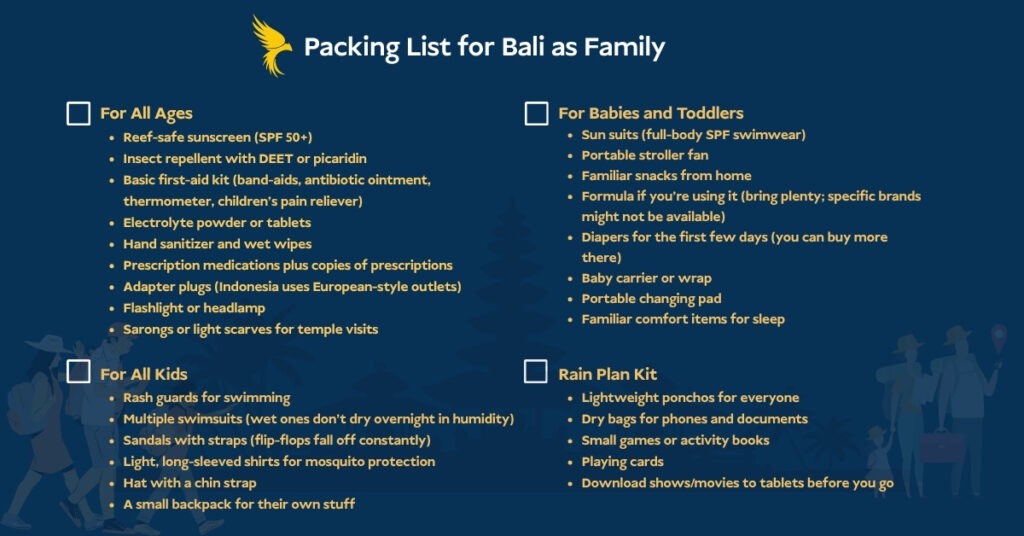
Baby gear rental: Don’t fly with everything. Rent cribs, high chairs, bottle sterilizers, pool fences, and even toys from baby gear companies in Bali. They deliver to your villa or hotel and pick up when you’re done.
FAQs (Short, Specific, Up-to-Date)
Is Bali stroller-friendly?
Partially. Sanur and Nusa Dua have paved paths that work great with strollers. Seminyak, Canggu, and Ubud are rough, broken sidewalks, steps, and uneven terrain. Bring a sturdy stroller with good wheels, or better yet, bring a baby carrier for flexibility.
Do we need car seats, and where do we get them?
Indonesian taxis and drivers rarely have car seats. You can bring your own (check airline policies on free checked car seats), rent them from baby gear companies in Bali, or bring a portable booster/travel harness. It’s not ideal, but it’s better than nothing.
Can I extend a VOA with kids in tow?
Yes, but it’s a hassle. You’ll need to visit an immigration office, bring everyone’s passports and photos, fill out forms, and wait. It’s much easier to use a service like Visa-Indonesia.com that handles the paperwork and appointment scheduling for you.
What if a child gets sick? Where do we go?
BIMC Hospital (in Kuta and Nusa Dua) and Siloam Hospital (in Denpasar) have English-speaking doctors, modern facilities, and 24/7 emergency care. They’re expensive but excellent. Keep your travel insurance info and all receipts. For minor issues, pharmacies (apotek) are everywhere and pharmacists can recommend basic medications.
Is tap water safe? What about ice?
No, never drink tap water in Bali. Only bottled or filtered water. Ice at nice hotels and restaurants is made from filtered water and is safe. Ice at small warungs or street vendors might not be, when in doubt, skip it.
How do I handle the heat with babies and toddlers?
Dress them in light, breathable clothing. Use sunscreen constantly. Plan outdoor activities before 10 AM and after 4 PM. Keep them in shade during midday. Offer water constantly, babies need breast milk or formula more frequently in heat, toddlers need water every 20-30 minutes. Watch for signs of overheating: flushed face, excessive fussiness, and less urination.
Are there kids’ menus at restaurants?
Bigger tourist restaurants have them. Smaller warungs don’t, but will make plain rice, noodles, or mild dishes if you ask. Bring backup snacks just in case.
What’s the best way to handle jet lag with kids?
Get everyone on Bali time as quickly as possible. Arrive in the morning if you can, spend the day outside in natural light, and try to keep everyone awake until a reasonable bedtime. The first few days will be rough, plan easy activities and build in extra nap time. Melatonin can help older kids (ask your pediatrician before the trip). Accept that the first 2-3 days will be weird, and schedule your villa or resort accordingly so you’re not jumping into tours immediately.
Bali with kids is absolutely doable, and it can be the trip your family talks about for years. The key is planning realistically, not cramming too much in, respecting the heat and distances, and building flexibility into your schedule. Get your visas sorted early, pick the right base for your kids’ ages, follow basic health and safety rules, and give yourself permission to skip things if everyone’s tired.
Your kids won’t remember every temple or rice terrace. They’ll remember swimming in warm water, eating strange new foods, seeing monkeys up close, and that time you all got caught in a rainstorm and laughed instead of stressed. Plan the logistics carefully so you can be present for those moments.
Safe travels, and have an amazing adventure.
Ready to Apply or Extend Your Visa?
Let our visa specialists handle your application.

